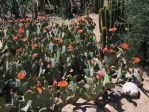
Coulter, Contributions from the U. S. National Herbarium 3: 432, 1892-1896
Herbarium; Herbarium; Herbarium; Herbarium (holotype, deposited as O. magenta); Lectotype (O. mesacantha vaseyi); Herbarium; Herbarium; Herbarium; Holotype (O. intricata); Isotype (O. intricata);
Original Description (as O. mesacantha vaseyi)
What is Opuntia vaseyi?
Opuntia vaseyi is a low, spreading, bushy prickly pear cactus found “along and near the coast of southern California.” It often forms thickets 25 to 40 cm tall.
Details
Cladodes are elongate-obovate and generally narrow, but exceptions occur. The cladodes have relatively large areoles and 2-3(4) reddish-brown spines that may be deflexed. Spines may be 1.5 to 3 cm long.
Most plants have pink-, red-, or magenta-colored flowers, but some plants have yellow flowers. The pinkish or reddish flowers are a diagnostic feature of the plant in southern California. The fruit of this Opuntia is essentially spineless and about 5 cm long.
O. vaseyi is hexaploid, but the number was reported for older names, which were considered to be hybrids at the time (O. ×vaseyi and O. littoralis ×O.
phaeacantha). O. vaseyi is a discrete species and not a hybrid.
Other Notes
This cactus has variously been known by many names including O. magenta, O. intricata, O. vaseyi var magenta, and O. rubiflora. It was even lumped into O. littoralis. When first described the taxon was named Opuntia mesacantha vaseyi.
Britton and Rose pointed out that the type locality of Arizona must be presumed to be wrong because the prickly pear is found only in Southern California.
For more information, see:
Majure, L.C., Puente, R., Griffith M.P, Judd W.S., Soltis P.S and Soltis, D.E. (2012) Phylogeny of Opuntia s.s. (Cactaceae): Clade delineation, geographic origins, and reticulate evolution. American Journal of Botany, 99:847.














